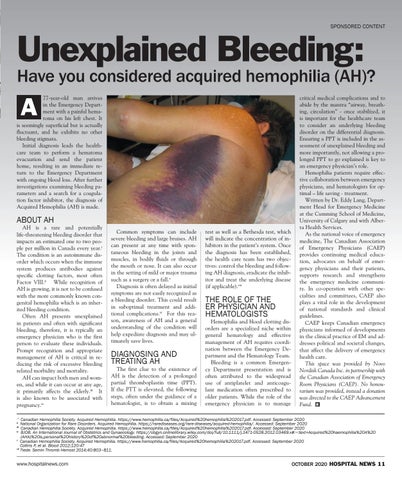SPONSORED CONTENT
Unexplained Bleeding:
Have you considered acquired hemophilia (AH)?
77-year-old man arrives in the Emergency Department with a painful hematoma on his left chest. It is seemingly superficial but is actually fluctuant, and he exhibits no other bleeding stigmata. Initial diagnosis leads the healthcare team to perform a hematoma evacuation and send the patient home, resulting in an immediate return to the Emergency Department with ongoing blood loss. After further investigations examining bleeding parameters and a search for a coagulation factor inhibitor, the diagnosis of Acquired Hemophilia (AH) is made.
A
ABOUT AH
AH is a rare and potentially life-threatening bleeding disorder that impacts an estimated one to two people per million in Canada every year.i The condition is an autoimmune disorder which occurs when the immune system produces antibodies against specific clotting factors, most often Factor VIII.ii While recognition of AH is growing, it is not to be confused with the more commonly known congenital hemophilia which is an inherited bleeding condition. Often AH presents unexplained in patients and often with significant bleeding, therefore, it is typically an emergency physician who is the first person to evaluate these individuals. Prompt recognition and appropriate management of AH is critical in reducing the risk of excessive bleeding related morbidity and mortality. AH can impact both men and women, and while it can occur at any age, it primarily affects the elderly.iii It is also known to be associated with pregnancy.iv
Common symptoms can include severe bleeding and large bruises. AH can present at any time with spontaneous bleeding in the joints and muscles, in bodily fluids or through the mouth or nose. It can also occur in the setting of mild or major trauma such as a surgery or a fall.v Diagnosis is often delayed as initial symptoms are not easily recognized as a bleeding disorder. This could result in suboptimal treatment and additional complications.vi For this reason, awareness of AH and a general understanding of the condition will help expediate diagnosis and may ultimately save lives.
DIAGNOSING AND TREATING AH
The first clue to the existence of AH is the detection of a prolonged partial thromboplastin time (PPT). If the PTT is elevated, the following steps, often under the guidance of a hematologist, is to obtain a mixing
test as well as a Bethesda test, which will indicate the concentration of inhibitors in the patient’s system. Once the diagnosis has been established, the health care team has two objectives: control the bleeding and following AH diagnosis, eradicate the inhibitor and treat the underlying disease (if applicable).vii
THE ROLE OF THE ER PHYSICIAN AND HEMATOLOGISTS
Hemophilia and blood clotting disorders are a specialized niche within general hematology and effective management of AH requires coordination between the Emergency Department and the Hematology Team. Bleeding is a common Emergency Department presentation and is often attributed to the widespread use of antiplatelet and anticoagulant medication often prescribed to older patients. While the role of the emergency physician is to manage
critical medical complications and to abide by the mantra “airway, breathing, circulation” - once stabilized, it is important for the healthcare team to consider an underlying bleeding disorder on the differential diagnosis. Ensuring a PPT is included in the assessment of unexplained bleeding and more importantly, not allowing a prolonged PPT to go explained is key to an emergency physician’s role. Hemophilia patients require effective collaboration between emergency physicians, and hematologists for optimal – life saving - treatment. Written by Dr. Eddy Lang, Department Head for Emergency Medicine at the Cumming School of Medicine, University of Calgary and with Alberta Health Services. As the national voice of emergency medicine, The Canadian Association of Emergency Physicians (CAEP) provides continuing medical education, advocates on behalf of emergency physicians and their patients, supports research and strengthens the emergency medicine community. In co-operation with other specialties and committees, CAEP also plays a vital role in the development of national standards and clinical guidelines. CAEP keeps Canadian emergency physicians informed of developments in the clinical practice of EM and addresses political and societal changes, that affect the delivery of emergency health care. This space was provided by Novo Nordisk Canada Inc. in partnership with the Canadian Association of Emergency Room Physicians (CAEP). No honourarium was provided, instead a donation was directed to the CAEP Advancement H Fund. Q
Canadian Hemophilia Society. Acquired Hemophilia. https://www.hemophilia.ca/files/Acquired%20hemophilia%202017.pdf. Accessed: September 2020 National Organization for Rare Disorders. Acquired Hemophilia. https://rarediseases.org/rare-diseases/acquired-hemophilia/. Accessed: September 2020 Canadian Hemophilia Society. Acquired Hemophilia. https://www.hemophilia.ca/files/Acquired%20hemophilia%202017.pdf. Accessed: September 2020 iv BJOB. An International Journal of Obstetrics and Gynaecology. https://obgyn.onlinelibrary.wiley.com/doi/full/10.1111/j.1471-0528.2012.03469.x#:~:text=Acquired%20haemophilia%20A%20 (AHA)%20is,personal%20history%20of%20abnormal%20bleeding. Accessed: September 2020 v Canadian Hemophilia Society. Acquired Hemophilia. https://www.hemophilia.ca/files/Acquired%20hemophilia%202017.pdf. Accessed: September 2020 Collins P, et al. Blood 2012;120:47 vii Tiede. Semin Thromb Hemost 2014;40:803–811. i
ii
iii
www.hospitalnews.com
OCTOBER 2020 HOSPITAL NEWS 11
